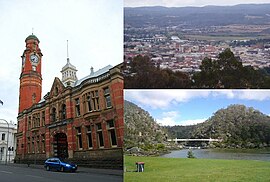Launceston, Tasmania
|
Launceston Tasmania |
|||||||||||||
|---|---|---|---|---|---|---|---|---|---|---|---|---|---|

Montage of Launceston. Clockwise from left – Launceston Post Office, View of the CBD and inner suburbs from Woods Reserve and Cataract Gorge and Alexandra Suspension Bridge
|
|||||||||||||
| Coordinates | 41°26′31″S 147°8′42″E / 41.44194°S 147.14500°ECoordinates: 41°26′31″S 147°8′42″E / 41.44194°S 147.14500°E | ||||||||||||
| Population | 86,633 (2015) (20th) | ||||||||||||
| • Density | 198.973/km2 (515.34/sq mi) | ||||||||||||
| Established | 1806 | ||||||||||||
| Postcode(s) | 7250 | ||||||||||||
| Area | 435.4 km2 (168.1 sq mi) (2011 urban) | ||||||||||||
| Time zone | AEST (UTC+10) | ||||||||||||
| • Summer (DST) | AEDT (UTC+11) | ||||||||||||
| Location |
|
||||||||||||
| LGA(s) | City of Launceston | ||||||||||||
| Federal Division(s) | |||||||||||||
|
|||||||||||||
|
|||||||||||||
Launceston (![]() i/ˈlɒnsəstən/, often mispronounced
i/ˈlɒnsəstən/, often mispronounced ![]() i/ˈlɔːnsəstən/) is a city in the north of Tasmania, Australia at the junction of the North Esk and South Esk rivers where they become the Tamar River. Launceston is the second largest city in Tasmania after Hobart. With a population of 86,633, Launceston is the twelfth-largest non-capital city in Australia. It is the only inland city in Tasmania.
i/ˈlɔːnsəstən/) is a city in the north of Tasmania, Australia at the junction of the North Esk and South Esk rivers where they become the Tamar River. Launceston is the second largest city in Tasmania after Hobart. With a population of 86,633, Launceston is the twelfth-largest non-capital city in Australia. It is the only inland city in Tasmania.
...
Wikipedia

